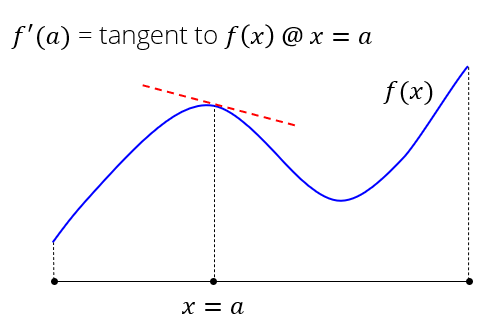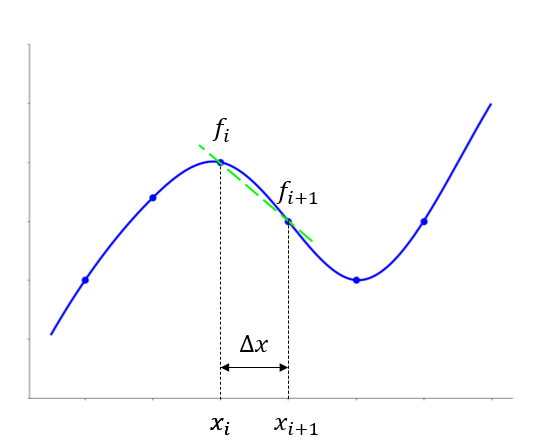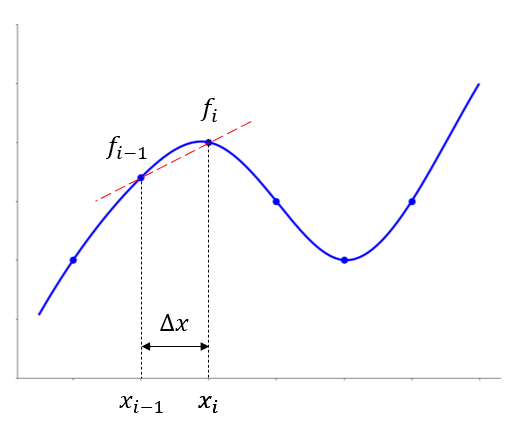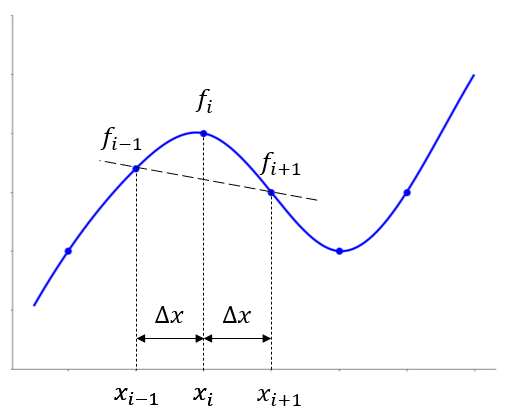Numerical Differentiation#
Derivatives#
The derivative of a function is the change in function due to an infinitesimal change in its input
Mathematically, the derivative is:

Numerical Derivatives#
Finite difference (FD) approximation of the derivative
Use the function values at two (or more) points in the neighborhood
Three FD approximations using two points are commonly employed:
Forward difference
Backward difference
Central difference
Forward Difference#
Derivative of the function \(f(x)\) at \(x=x_i\) is approximated as the slope of a line connecting two points:
\((x_i, f(x_i))\)
\((x_{i+1}, f(x_{i+1}))\)
Denoting \( x_{i+j} = x_i + j\Delta x \) and \( f_{i} = f(x_{i}) \):

Backward Difference#
Derivative of the function \(f(x)\) at \(x=x_i\) is approximated as the slope of a line connecting two points:
\((x_{i-1}, f(x_{i-1}))\)
\((x_i, f(x_i))\)

Central Difference#
Derivative of the function \(f(x)\) at \(x=x_i\) is approximated as the slope of a line connecting two points:
\((x_{i-1}, f(x_{i-1}))\)
\((x_{i+1}, f(x_{i+1}))\)

Illustration#
%matplotlib widget
import numpy as np
import matplotlib.pyplot as plt
from ipywidgets import interactive
from IPython.display import display
plt.rcParams['figure.figsize'] = [9.6, 7.2]
fs = 16
ls = 16
lw = 2
# Function f
def f(x):
return 0.5 + 0.046*x + 0.07*x**2 - 0.032*x**3 + 0.0033*x**4
# Derivative of function f
def dfdx(x):
return 0.046 + 0.14*x - 0.096*x**2 + 0.0132*x**3
# New matplotlib figure
fig, ax = plt.subplots()
# Arrays for plotting function f
xnew = np.arange(0.8, 7, 0.01)
ynew = f(xnew)
# Plot update function for interactive widget
def plot_update(mthd, xi=2.5, dx=0.5):
ax.clear()
ax.plot(xnew, ynew, 'blue', lw=lw)
# Decorate the plot
ax.set_xlabel('$\it{x}$', fontsize=fs)
ax.set_ylabel('$f(x)$', fontsize=fs)
ax.set_xlim(0, 8)
ax.set_ylim(0.5, 0.8)
#ax.tick_params(axis='both', labelsize=ls)
ax.get_xaxis().set_ticklabels([])
ax.get_yaxis().set_ticklabels([])
for pos in ['top', 'right']:
ax.spines[pos].set_visible(False)
# Dynamic part
ui = f(xi)
uib = f(xi-dx)
uif = f(xi+dx)
ax.plot([xi],[ui], 'black', linestyle='None', marker='o', markersize=8)
ax.plot([-10,xi], [ui, ui], 'black', lw=0.2*lw)
ax.plot([xi,xi], [-10, ui], 'black', lw=0.2*lw)
if mthd != 'Forward':
ax.plot([xi - dx], [uib], 'red', linestyle='None', marker='o', markersize=8)
ax.text(xi-dx-1., 0.525, r'$x_i - \Delta x = x_{i-1}$' + '\n' + r'$\Delta x = $' + f'{dx:.2f}', style='italic', fontsize=15)
ax.plot([xi-dx,xi-dx],[-10, uib], 'black', lw=0.2*lw)
if mthd != 'Backward':
ax.plot([xi+dx], [uif], 'blue', linestyle='None', marker='o', markersize=8)
ax.text(xi+dx+0.07, 0.525, r'$x_{i+1} = x_i + \Delta x$' + '\n' + r'$\Delta x = $' + f'{dx:.2f}', style='italic', fontsize=15)
ax.plot([xi+dx,xi+dx],[-10, uif], 'black', lw=0.2*lw)
ax.text(xi-0.18, 0.485, f'$x_i = {xi}$', style='italic', fontsize=15)#, bbox={'facecolor': 'white', 'alpha': 0.5, 'pad': 10})
ax.text(-0.65, ui, '$f_i = $'+ f'{ui:.2f}', style='italic', fontsize=15)
#ax.arrow(xi, 0.55, dx, 0, width=0.01*dx)
#ax.annotate('$x_i = $' + str(xi), xy=(xi, ui), xytext=(1, 0.77))
#arrowprops=dict(facecolor='black', shrink=0.05),)
# Tangent
yTgnt = dfdx(xi)*(xnew-xi) + ui
ax.plot(xnew, yTgnt, 'black', lw=0.5*lw)
# Approximation
m = (uif - ui)/dx
text = r'$ \frac{df}{dx} \approx \frac{f_{i+1} - f_i}{x_{i+1} - x_i} = \frac{f_{i+1} - f_i}{\Delta x}$'
if mthd == 'Backward':
m = (ui - uib)/dx
text = r'$ \frac{df}{dx} \approx \frac{f_{i} - f_{i-1}}{x_{i} - x_{i-1}} = \frac{f_{i} - f_{i-1}}{\Delta x}$'
elif mthd == 'Central':
m = (uif - uib)/dx/2
text = r'$ \frac{df}{dx} \approx \frac{f_{i+1} - f_{i-1}}{x_{i+1} - x_{i-1}} = \frac{f_{i+1} - f_{i-1}}{2 \Delta x}$'
yApprx = m*(xnew - xi) + ui
fsText = 14
ax.plot(xnew, yApprx, 'magenta', linestyle='dashed', lw=0.5*lw)
ax.text(0.4, 0.76, text, style='italic', fontsize=fsText)
ax.text(0.4, 0.78, r'$\frac{df}{dx} \approx $' + f' slope of magenta curve = FD approximation = {m:.4f}', style='italic', fontsize=fsText)
ax.text(0.4, 0.80, r'$\frac{df}{dx} = $' + f' slope of tangent (black curve) = {dfdx(xi):.4f}', style='italic', fontsize=fsText)
#fig.canvas.draw_idle()
#plt.show()
# Widget for interactive plotting
interactive_plot = interactive(plot_update, mthd=['Forward','Backward', 'Central'],
xi=(0.5, 7, 0.1),
dx=(0.01, 0.8, 0.02))
output = interactive_plot.children[-1]
interactive_plot.children[0].description = 'FD Scheme'
#interactive_plot.children[1].description = r'$ \Delta x$'
#interactive_plot.children[1].value = 2.5
#interactive_plot.children[2].value = 0.5
#output.layout.height = '300px'
display(interactive_plot)
---------------------------------------------------------------------------
ModuleNotFoundError Traceback (most recent call last)
Cell In[1], line 1
----> 1 get_ipython().run_line_magic('matplotlib', 'widget')
2 import numpy as np
3 import matplotlib.pyplot as plt
File /opt/hostedtoolcache/Python/3.11.9/x64/lib/python3.11/site-packages/IPython/core/interactiveshell.py:2480, in InteractiveShell.run_line_magic(self, magic_name, line, _stack_depth)
2478 kwargs['local_ns'] = self.get_local_scope(stack_depth)
2479 with self.builtin_trap:
-> 2480 result = fn(*args, **kwargs)
2482 # The code below prevents the output from being displayed
2483 # when using magics with decorator @output_can_be_silenced
2484 # when the last Python token in the expression is a ';'.
2485 if getattr(fn, magic.MAGIC_OUTPUT_CAN_BE_SILENCED, False):
File /opt/hostedtoolcache/Python/3.11.9/x64/lib/python3.11/site-packages/IPython/core/magics/pylab.py:103, in PylabMagics.matplotlib(self, line)
98 print(
99 "Available matplotlib backends: %s"
100 % _list_matplotlib_backends_and_gui_loops()
101 )
102 else:
--> 103 gui, backend = self.shell.enable_matplotlib(args.gui.lower() if isinstance(args.gui, str) else args.gui)
104 self._show_matplotlib_backend(args.gui, backend)
File /opt/hostedtoolcache/Python/3.11.9/x64/lib/python3.11/site-packages/IPython/core/interactiveshell.py:3665, in InteractiveShell.enable_matplotlib(self, gui)
3662 import matplotlib_inline.backend_inline
3664 from IPython.core import pylabtools as pt
-> 3665 gui, backend = pt.find_gui_and_backend(gui, self.pylab_gui_select)
3667 if gui != None:
3668 # If we have our first gui selection, store it
3669 if self.pylab_gui_select is None:
File /opt/hostedtoolcache/Python/3.11.9/x64/lib/python3.11/site-packages/IPython/core/pylabtools.py:338, in find_gui_and_backend(gui, gui_select)
321 def find_gui_and_backend(gui=None, gui_select=None):
322 """Given a gui string return the gui and mpl backend.
323
324 Parameters
(...)
335 'WXAgg','Qt4Agg','module://matplotlib_inline.backend_inline','agg').
336 """
--> 338 import matplotlib
340 if _matplotlib_manages_backends():
341 backend_registry = matplotlib.backends.registry.backend_registry
ModuleNotFoundError: No module named 'matplotlib'
Derivation from Taylor Series Expansions#
FD approximations have their basis in Taylor’s series expansion of \(f(x)\)
Which generalizes to:
Here:
Forward differencing
Rearranging
Forward diferencing truncation error = \(O(\Delta x)\)
Backward differencing
Rearranging
Backward diferencing truncation error = \(O(\Delta x)\)
Central differencing (combining forward and backward schemes)
Rearranging
Central diferencing truncation error = \(O(\Delta x)^2\)
Central differencing is more accurate than forward and backward differencing when \(|\Delta x| < 1\)
Python Implementation#
Numerical derivative of \(f(x) = cos(x)\)
Exact derivative is \(f^\prime(x) = -sin(x)\)
import numpy as np
#step size
dx = 0.1*np.pi
x = np.arange(0, 4*np.pi + 0.001, dx) # Add a small number to include the end value too
# Exact derivative
dfdx_exact = -np.sin(x)
# Forward difference approximation - non-numpy
f = np.cos(x)
dfdx_fd = []
for i in range(0,len(x)-1):
dfdx_fd.append((f[i+1] - f[i])/(dx))
Visualize the
ndarrayas a table:
The finite difference approximations can be computed by taking difference of sub-arrays of these arrays
For example, consider forward difference approximation:
Then the numerator for points \((x_0, x_1, \cdots, x_{n-1})\) is:
\[\begin{split} \begin{array}{|c|c|c|c|c|c|c|c|c|c|c|c|c|} \hline f_1 & f_2 & f_3 & \cdots & f_{i-1} & f_{i} & f_{i+1} & \cdots & f_{n-2} & f_{n-1} & f_{n} \\ \hline \end{array} \\ - \\ \begin{array}{|c|c|c|c|c|c|c|c|c|c|c|c|c|} \hline f_0 & f_1 & f_2 & \cdots & f_{i-2} & f_{i-1} & f_{i} & \cdots & f_{n-3} & f_{n-2} & f_{n-1} \\ \hline \end{array} \end{split}\]
Note: Forward difference approximation cannot be computed at \(x = x_{n}\), no \(x_{n+1}\) available
The denominator can be computed likewise if the discretization is not uniform
Programatically this is:
# Forward difference approximation - numpy way
dfdx_fwd = (f[1:] - f[0:-1])/dx
# Central difference approximation - numpy way
dfdx_cen = (f[2:] - f[0:-2])/2/dx
fig, ax = plt.subplots()
ax.plot(x, -np.sin(x), '-k', label="f'(x) (exact)")
ax.plot(x[0: -1], dfdx_fwd, '--r', label="f'(x) (forward)")
ax.plot(x[1: ], dfdx_fwd, '-.g', label="f'(x) (backward)")
ax.plot(x[1: -1], dfdx_cen, '-ob', label="f'(x) (centra)")
ax.legend()
<matplotlib.legend.Legend at 0x15374f3ce050>
# Define the function to differentiate
def f(x):
return np.sin(x)
# Define the analytical derivative of the function
def f_prime(x):
return np.cos(x)
# Define the forward difference numerical differentiation scheme
def forward_diff(f, x, h):
return (f(x + h) - f(x)) / h
# Define the backward difference numerical differentiation scheme
def backward_diff(f, x, h):
return (f(x) - f(x - h)) / h
# Define the central difference numerical differentiation scheme
def central_diff(f, x, h):
return (f(x + h) - f(x - h)) / (2*h)
# Define the range of x values to plot
x = np.linspace(0, 2*np.pi, 1000)
# Define the initial step size for differentiation
h0 = 0.1
# Define the interactive function that generates the plot
def plot_diff(h=0.5):
# Calculate the derivatives using each scheme
df_forward = forward_diff(f, x, h)
df_backward = backward_diff(f, x, h)
df_central = central_diff(f, x, h)
# Plot the original function and its derivatives
plt.figure(figsize=(8, 6))
#plt.plot(x, f(x), label='f(x)')
plt.plot(x, f_prime(x), '-k', label="f'(x) (exact)")
plt.plot(x, df_forward, '--r', label="f'(x) (forward)")
plt.plot(x, df_backward, '--g', label="f'(x) (backward)")
plt.plot(x, df_central, ':b', label="f'(x) (central)")
plt.legend()
plt.title("Numerical differentiation schemes")
plt.xlabel("x")
plt.ylabel("y")
plt.show()
# Create the interactive plot
interactive_plot = interactive(plot_diff, h=(0.01, 1.1, 0.1))
interactive_plot
Second Derivatives#
Finite difference approximation of 2nd derivative \(f''(x)\)
Derivative of the derivative; use any of the 1st order approximations
If using central difference:
Other higher accuary approximation and for higher order derivatives can be obtained from the Taylor series approximation
Example: a higher accuracy (\(O(\Delta x^4)\)) FD approximation for the 2nd derivative \(f''(x)\)
dx = 0.2*np.pi
x = np.arange(0,4*np.pi, dx)
f = np.cos(x)
d2f_3pt = []
d2f_5pt = []
for i in range(2,len(x)-2):
d2f_3pt.append((f[i+1] - 2*f[i] + f[i-1])/dx**2)
d2f_5pt.append((-f[i+2] + 16*f[i+1] - 30*f[i] + 16*f[i-1] - f[i-2])/(12*dx**2))
fig, ax = plt.subplots()
ax.plot(x[2:-2], d2f_3pt, '--r', label='$2^{nd}$-order approx', lw=2)
ax.plot(x[2:-2], d2f_5pt, '-.b', label='$4^{th}$-order approx', lw=2)
x = np.arange(0,4*np.pi, dx/10)
ax.plot(x, -np.cos(x), '-k', label = 'exact')
ax.legend();
Procedure for FD Approximations#
Procedure for FD approximation of \(f^{(n)}(x_i)\):
Write the approximation for \(f^{(n)}(x_i)\) as a linear combination of \(\cdots, f(x_{i-2}), f(x_{i-1}), f(x_i), f(x_{i+1}), f(x_{i+2}), \cdots\)
The number of points used determines the accuracy of the approximation, but requires more function evaluations
If using \(2 p + 1\) points with \(p\) points on either side of \(x_i\):
-
- Here, as before, $x_{i+j} = x_i + j \Delta x$ and $a_j$ are coefficients to be determined
-
- Use Taylor series about $x=x_i$ to expand all the terms on RHS
- Collect the terms and choose $a_j$ such that the coefficients of:
- the lower order derivative terms (i.e., $f^{(n-1)}(x_i), f^{(n-2)}(x_i),\cdots,f^{(1)}(x_i), f(x_i)$) all vanish
- $f^{(n)}(x_i)$ is 1
- The remaining higher order terms form the truncation error
Example: FD approximation for \(f^{(2)}(x_i)\) using 3 points
Coefficient of \(f^{(n)}(x_i)\) is:
If \(n\) is odd: \((a_1 - a_{-1}) \frac{(\Delta x)^n}{n!}\)
If \(n\) is even: \((a_1 + a_{-1}) \frac{(\Delta x)^n}{n!}\)
The coefficient of \(f^{(1)}(x_i)\) must vanish \(\implies a_1 = a_{-1}\)
The coefficient of \(f(x_i)\) must vanish \(\implies a_0 = -2 a_1\)
The coefficient of \(f^{(2)}(x_i)\) must vanish too \(\implies 2 a_1 \frac{\Delta x^2}{2!} - 1 = 0\)
Solving the equation gives \(a_1 = 1/(\Delta x)^2\)
Thus the FD approximation of \(f^{(2)}(x_i)\) with 3 points is:
The truncation error is \(O(\Delta x^2)\) and given by: